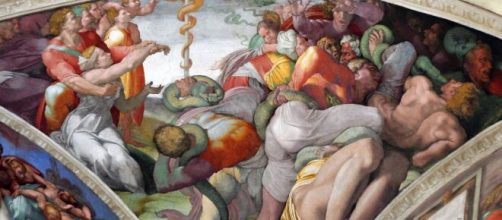After six centuries, there’s little left to learn about Michelangelo’s Sistine Chapel ceiling painting. But wait, something new has surfaced that undercuts his reputation set forth by his fellow Renaissance painters that he was “The Divine One.”
The Observer reports that a sketch of a nude male’s back is a preparatory red chalk drawing for the figure fighting serpents in the Sistine Chapel ceiling painting. Paul Joannides, the preeminent authority on Michelangelo, has authenticated the sketch.
This is big news
Any preparatory sketch for the Sistine Chapel ceiling is a rarity.
As art historian Giorgio Vasari made clear in his 1550 book “The Lives of the Most Excellent Painters, Sculptors, and Architects,” Michelangelo burned a “large number” of his drawings for the ceiling painting.
By way of explaining the destruction of the sketches, Vasari said that just before Michelangelo died, he set the drawings on fire “to prevent anyone from seeing the labors he endured...for fear he might seem less than perfect.”
Did you get that? Michelangelo worried about maintaining his image, the one perpetuated by his colleagues that he was divine. Or, as Vasari put it, that “God sent him to bring absolute perfection to Earth.”
Getting tagged as God’s gift to the world must have been hard to live up to.
Clearly, Michelangelo sought to make Vasari’s praise of his “absolute perfection” real. By destroying his drawings, he gave the impression that his work was spontaneous without the artist’s usual struggle.
When it comes to the usual struggles, the High Renaissance’s other great master painter Raphael comes to mind. In his search for ideal beauty, he made plain that he worried he wasn’t as good as people said he was.
Referring to a painting for one of his clients, he wrote: “Whether this is possessed of any artistic excellence, I do not know. But I strive to attain it.” Unlike Michelangelo, Raphael freely admitted the struggle.
I rush to say that Michelangelo did his striving in an out-of-the-ordinary way – painting the Chapel ceiling while lying on his back looking upward for four years.
Now that’s an incontestable bragging right.
What Ginger Rogers said
Painting the complete story of Creation on a ceiling on one’s back is reminiscent of what Fred Astaire’s dance partner Ginger Rogers said when he was praised as the better dancer:“ I did everything that he did, but backward and in high heels.”
Michelangelo should have gone with something like that: remind the world of laboring on his back with his face turned up. This so impaired his eyesight that he couldn’t read or look at his drawings except with his head turned backward for several months.
Yet, in this contorted position, Michelangelo achieved perfect form and foreshortening, not to mention a wide range of differently posed figure types of all shapes and ages.
Despite his arduous efforts, he refused to acknowledge it.
In a conversation with his friend Vittoria Colonna, recorded by Francisco De Hollanda, he said: "To copy the human figure seems to me to be indeed to imitate the work of God."
By destroying his preparatory drawings, Michelangelo kept the myth going that he didn’t struggle to get his figures perfect. He only had to "imitate the work of God." Easy peasy.


